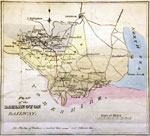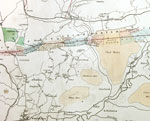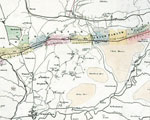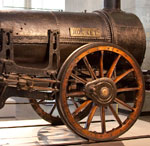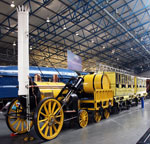One Track Minds
The British Made the Modern Railroad that Made American Fortunes By Derek Hayes
I’ve lately been working on a new book, a historical atlas of the North American railroad, and took the opportunity to visit Britain, the birthplace of the railway, to look at some of the very early attempts to create steam-powered locomotives. Many of the first American railroad engineers visited Britain in the late 1820s and early 1830s to investigate what the British were up to and learn from their experiences. Officials from the nascent Baltimore and Ohio Railroad, for example, were present at the famous Rainhill Trials in 1829, when Robert Stephenson’s Rocket, boasting a number of technical innovations, bested several other competitors to become the locomotive of choice for the Liverpool & Manchester Railway; it opened the following year, becoming the world’s first steam-powered, regularly scheduled railway. A number of the very earliest steam locomotives to run in North America were imported from Britain. One was the first commercial locomotive to run in America, the Stourbridge Lion, which ran on the Delaware & Hudson on August 8, 1829—though the venture failed because the locomotive proved too heavy for the flimsy wooden and strap-iron tracks.
In my search for information, I naturally found a few maps. At the National Railway Museum in York, I saw a map of the Stockton & Darlington Railway, planned and built by George Stephenson. This railway opened in 1825 and was the first to carry passengers between cities using steam power, although, as I found out, after the first and famous blaze of glory on opening day, the railway reverted to using horses for its passenger services and only used its precious steam locomotives for hauling coal. Not until 1833 did the railway regularly use steam locomotives for passengers. Its first locomotive, built by Stephenson, was the famous Locomotion, now preserved at a museum in Darlington. It was rather exciting—at least for a map nut like me—to be handling the actual maps used to plan the world’s first passenger railway. The line was primarily intended to transport coal from collieries inland to tidewater at Stockton; passengers were almost an afterthought. The line not only ran between Stockton and Darlington but also extended farther inland beyond Darlington to reach the coalfields. It would have more accurately been named the West Auckland and Stockton Railway had it designated its start and end points.
I also visited the U.K. National Archives, located only a few hundred yards from the Royal Botanical Gardens in Kew, on the west side of London. There I found more early railway maps, including one from a prospectus published in 1821, directed at potential investors in the company. We sometimes forget that these historical events required capital, and that this had to come from somewhere—from investors who foresaw the promise of the new technology and hoped to make money from it (sound familiar?). It no doubt took quite a leap of faith in 1821 to invest in a railroad, largely untried as it was. But George Stephenson had by then produced a number of steam engines—his first was Blücher in 1814 (named after the Prussian general who was then an ally of Britain and who would be decisive in helping the Duke of Wellington defeat Napoleon at the Battle of Waterloo the following year).
What the prospectus makes quite clear—and I hadn’t realized this before—was that the railway was intended to be horse operated. The use of a steam engine—the Locomotionówas the result of later lobbying by Stephenson. “A Rail-way can be formed upon which four Horses can take as much at one time as now employs forty horses,” the prospectus gushed, “[so that] the utility of such a Road is strikingly manifest.” This economical use of horses probably attracted investors more than anything else, for the Napoleonic Wars had considerably increased the price of horse fodder in Britain, so the timing was right and alternative technology was most welcome. Indeed, the prospectus made pains to note that “a great nuisance will be removed from the Roads of this county,” then “infested with one-horse carts.”









